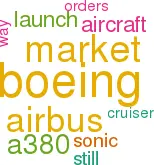Seattle's sonic tonic
April 2001


There was certain panache in the manner in which Boeing has just retreated from the super–jumbo market. Faced with a dearth of launch orders for its stretched 747X, Boeing was left in the embarrassing position of withdrawing from the market an aircraft which it had hitherto proclaimed as a much cheaper way to achieve the same performance as the all–new A380. So Alan Mulally, chief executive of Boeing Commercial Aircraft, decided to trumpet a paper aeroplane that has been under study in Seattle, the Sonic Cruiser, a 180–250 — seater to fly at Mach 0.95, some 15–20% faster than conventional jets, but without the noise problems of supersonic Concorde.
It was a public relations triumph. Seattle citizens, rocked by Boeing’s earlier decision to move its corporate headquarters to Texas or the mid–West and to move shift some more fuselage production to Kansas, suddenly had a morale booster. Boeing staff are calling the new aircraft the "Airbus–killer".
Yet there are still formidable technical hurdles to clear if Boeing is to produce an aircraft that shaves an hour off every 3,000 miles travelled without sending the fuel bill through the roof. And the haste with which the proposed project was unveiled suggests that it is still some way off. So does the lack of specific information on its performance.
Whatever the underlying status of the Sonic Cruiser, it is still a remarkable turn round for Boeing. As late as last October Alan Mulally was confident he was about to sign up his first launch customer for the 747X.
He had set his sights on Fedex, because cargo carriers had been showing interest in ever–larger aircraft. In the event, the Fedex order went to Airbus helping it reach the total it needed to formally launch the A380 in January; it now has 66 orders and 50 options.
Although it seems inconceivable that Boeing can walk away from the market for super–jumbos, it has for years been talking up the idea that international aviation is fragmenting and that travellers increasingly want to fly point–to–point rather than go through big hubs. It claims that the fragmentation it detects across the Atlantic is about to be repeated over the Pacific.
Based on this analysis Boeing has forecast only a small market for around 350 super–jumbos, compared with 1,550 in the view of Airbus. One reason for the huge difference is that Airbus claims that the A380 is a contender to replace the existing 747 so it counts the market for everything over 400 seats, while Boeing still sees that as a separate market, about the same size as that for the super–jumbo. But the essential difference between the two manufacturers is that Airbus believes the sheer volume of traffic flying between slot–constrained airports creates a market for the A380.
Airbus disconcerted
Privately Airbus executives cannot really believe that Boeing is walking away from what they see as a large and lucrative market, where they saw profits from the A380, even if it shared it equally with a Boeing product.
The nightmare that Airbus faces is that A380 orders, now that launch discounts will no longer be offered, slow to a trickle. BA continues to spurn the A380 and rely instead on 777s, despite facing continuing congestion at Heathrow, which the A380 is supposed to resolve. Another worry for Airbus is that when the sonic cruiser is finally launched, airlines like BA will use it to cream off business travellers on key routes, leaving the mass market for A380s and in the process undermining the aircraft’s economics (certainly no more on board jacuzzis or casinos).
Perhaps the most interesting facet of Boeing’s behaviour is how different it is from the past. When the original Airbus twin–engined widebodies were unveiled, Boeing dismissed them as ill–conceived and not what the market wanted, before going on to launch its own first twin–widebody, the 767. A similar thing happened when the A320 was launched, precipitating the 737NG project. This time Boeing has finally decided to go its own way and refuse to follow an Airbus initiative.